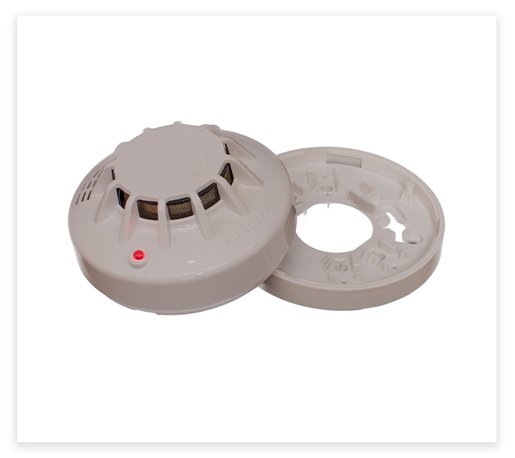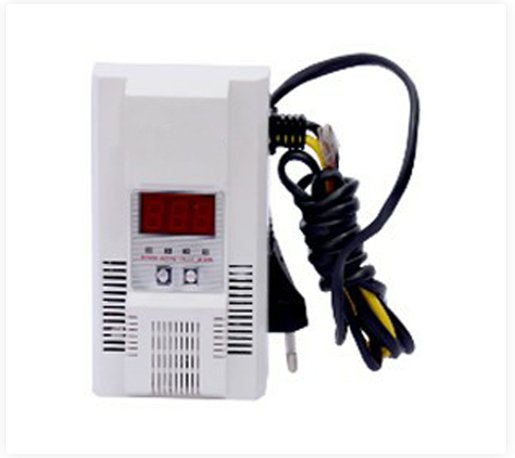Fire Alarm System > Detector
Optical Smoke Detector
The light scattering principle is the basis for how an optical smoke detector or photo-electric alert functions. The sensor chamber uses a pulsed infrared LED beam to check for smoke particles every 10 seconds. A fire in a no-smoking area is indicated by these smoke detectors. As a safety precaution, many commercial and industrial buildings utilize them. While residential fire alarms emit an audible or visual alert from the detector, commercial smoke detectors send a signal to the fire control panel. Smoke detectors are installed in plastic casings in the form of discs. Either the photoelectric method or ionization is used in the smoke detecting technique. Both of the sensing techniques are available to the detectors. Because domestic smoke detectors are networked, even if the power goes out in the house, if one of them detects smoke, the others will also sound an alarm. Hospitals, gyms, office buildings, factories, shopping centers, and commercial buildings are the main locations for smoke detectors.
Heat Detector
The most advanced optical sensing chamber is used by the conventional heat detector. This detector may be used with the majority of traditional fire alarm panels and is intended to protect open areas. The thermal component used by the conventional rate-of-rise heat detector senses changes in ambient temperature. When the temperature differential reaches the preset rate of rise or reaches the preset fixed value, a fire alarm may sound. It operates with a steady and trustworthy performance. Each detector has two LEDs that provide a local 360-degree visible alarm. Every six seconds, they flash to let you know that the detector is powered on and operating as intended. In alarm, the LEDs latch on. When there is a problem and the detector's sensitivity is more than the specified limit, the LEDs will turn off. The alarm can only be reset by a brief loss of electricity. Relays and the red LED on the detector that triggered off the alert will be latching until the panel resets them.
Standalone Smoke Detector
For your house or place of business, were you trying to find reasonably priced, high-quality standalone smoke detectors? If so, prepare to spend a significant portion of your income on the smoke detectors The Fire Wala sells.
Smoke detectors, as the name suggests, are fire safety tools that automatically identify smoke and alert building occupants when it is present. However, what is an independent smoke detector?
Smoke detectors can be classified into two primary categories: ionization and photoelectric. Ionization smoke detectors employ ionized particles to detect smoke, while photoelectric smoke detectors use a light source or sensor.
The autonomous detector runs on 9 volts. When a fire occurs, a standalone photoelectric smoke detector can quickly send out an alert and detect a significant volume of smoke. With its superior production technology and photoelectric smoke device, alarms are easy to install, stable in operation, visually appealing, and require no debugging. As a result, they are extensively used for fire safety monitoring in hotels, shops, internet cafes, lounges, and residential areas.
Uv Flame Detector
The Fire Wala is a fire alarm system manufacturer UV flame detectors react to light falling between 180 and 260 nanometers in spectrum. At relatively short ranges, they provide good sensitivity and fast reaction (0 – 50 ft). They are typically installed indoors due to their susceptibility to arc welding, halogen lights, and electrical discharges such as lightning. Failures may also result from thick, sooty smoke attenuating the incident UV light.
Beam Detector
Let's say you want to spend as little money as possible on the best beam detectors. If so, The Fire Wala has been producing high-quality beam detectors for a while, so you're in the ideal position to choose the best.
Beam detectors are typically utilized in fire alarm systems and are a type of detector that can detect both smoke and objects. When it detects smoke or items, it sounds the alert, averting tragic fire incidents. Reflector and receiver-transmitter beam detectors are the two varieties available on the market.
The receiver-transmitter is made up of a transmitter and a receiver, and it is through the transmitter that continuous infrared light beams are transferred to the receiver. The alarm sound will begin to sound if smoke gets in the way of the infrared light beams and stops them from reaching the receiver. Between the transmitter and the receiver, there can be a range of 5 to 100 meters.
There is a reflector and a unit in the reflector type. The receiver-transmitter unit's IR beams are typically reflected between the reflector and the unit. The distance between a reflector and the unit can range from 5 to 50 meters if there are more than three reflectors present, but it is just 5 to 35 meters if there is just one reflector.
A reflector must be used in conjunction with a conventional reflecting beam detector, which is a reflective infrared beam detector. With a powerful internal CPU, the detector offers great analytical and decision-making capabilities. The detector has the ability to automatically adapt the system, compensate for variations in environmental data, judge whether there is a fire or malfunction using a preset algorithm, and indicate these statuses using an LED and signal output terminals.
Lpg Leak Detector 12v/24v
We have a large selection of gas leak detectors for natural gas and LPG available. These systems function as comprehensive gas leak alarming devices that are perfect for identifying specific gas leaks and setting off alerts. It has audible alarm functionality. Recognized for their extended lifespan and effective operation,
Lpg Leak Detector 220v
We have a large selection of gas leak detectors for natural gas and LPG available. These systems function as comprehensive gas leak alarming devices that are perfect for identifying specific gas leaks and setting off alerts. It has audible alarm functionality. Recognized for their extended lifespan and effective operation,
Donate us to achive our goal
that they cannot foresee.





